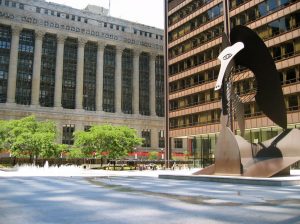Taylor Stewart, 25, a professional dancer and teacher, whose work is a fusion of modern, jazz and ballet, knows about the pain and pleasure of dance.
“There is a lot of stress on your back and on your feet. Especially with the jobs that you work as a dancer, you’re always on your feet. I think accompanied with what you put yourself through, technique classes and rehearsals, your body gets a lot of pains and injuries that you never had before,” Stewart said.
Stewart developed her first major injury from dancing at 14 and noted that “I had bone chips in my ankle, basically from over extending my foot my arch in my point shoe and pushing over. Somehow it got into my muscle in my ankles, so they had to go in and take that out and I’ve had back problems all my life, it comes with the territory.”
With each step, arm thrust, head spin, or back flip, the dancer aims to move with perfection. If there’s a misstep, the dancer tries to make sure the audience doesn’t know. David Ingram, 27, a professional dancer and choreographer, has experienced mistakes with different kinds of stunts when he is working on break dancing moves and aerobatics within a dance show.
“I’ve injured knees and back. I remember one show I did a “Suicide” as a break dancing move and I injured my back and the next day I woke up, I was completely stiff,” Ingram said.
A “Suicide” is a break dancing move where the subject does a back flip into the air, holds his ankles, lands on his back and gets back on his feet by doing a handspring off the floor.
“I had to go through two sessions of acupuncture just before I was 85 percent okay,” Ingram said.
Lyndsey Rhoads, 29, a professional dancer, choreographer and senior company member of Chicago Dance Crash Company explained some of the ways professional dancers try and take care of themselves.
“Eat healthy and take care of your body because we are asked to do things that shouldn’t be done, like the way we “twerk” our bodies in certain ways and the way we abused our bodies,” Rhoads said.
Dancers can be injured while performing but they dance on, and worry about the issues later. Rhoads has snapped her ACL in a middle of a show, during a solo.
“You have to make it to where the audience can’t tell that anything is wrong. So you have to fake through it and then at a certain point and time when it’s best to make your way off stage you leave.” Rhoads said.
She continued, there are “lots of injuries, dancers get injured all the time. We perform on injuries and sometimes it can’t be helped. If you’re in the middle of the show and there is no one to take your place you must bear with the pain, the show must go on.”
The adrenaline rush can get a dancer through a dire situations such as performing in front of a crowd on stage, but that rush doesn’t last long.
“Adrenaline usually kicks in during the injury. After the show is over and you’re driving home or sitting on your couch, within 20 minutes you’ll try to move and then you’ll feel the sharp pains. You basically have to grit your teeth, bear through it and go see your chiropractor or massage therapist,” Rhoads said.
Mark Brticevich, 56, fitness professional and a professor at the Fitness Center, trains and deals with injuries from dancers on a regular basis.
“Most of the dancers that I have dealt with suffer from overuse syndromes because they lock out their knees quite often they suffer from various knee injuries,” Brticevich said.
He wants to make sure that people learn how to take care of their bodies because the body is constantly at risk.
“You have to be fit, not just for dance but for life, so flexibility is essential but also stability in the joints. You can’t just be flexible enough or alone because some people are so flexible that their joints have no stability whatsoever, they’re going to be very prone to injuries,” he said.
Whenever a dancer is preparing to perform there should always be a period of prepping, such as warming up, stretching and practicing your form, according to Darlene Barry.
Barry, 21, a singer, song writer and dancer, has practiced African dance, ballet, jazz, tap and a little bit of gymnastics has rarely injured herself but has before.
“I was eight years old and I was doing turns and I wasn’t spotting then I fell on my foot. I slightly sprained my foot but there were times where my technique wasn’t up to par,” Barry said.
If a dancer doesn’t warm up that could just make things worse for a dance.
“Before you dance you always have to warm up. If we didn’t stretch then you would end up pulling something. The little things could mess up a person’s leg and make them be out for a month or possibly never dance again,” Barry said.
You’re always working, training and always doing something that is considered dance, Ingram said.
“Whether it’s choreographing, training, working, doing jobs, teaching class, taking class, it’s almost like sacrificing your time, so the time is the most demanding thing. If you love it, love what you’re doing then it’s actually going to be fun and you’re going to have a great time doing it,” Ingram said.
“It’s all for the love of entertaining.”
Related articles
- The Ugly Truth About Dance Injuries: My Experience (socialrhythms.wordpress.com)













Be First to Comment